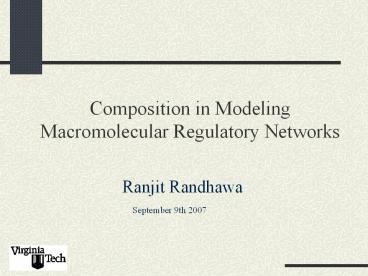Composition%20in%20Modeling%20Macromolecular%20Regulatory%20Networks - PowerPoint PPT Presentation
Title:
Composition%20in%20Modeling%20Macromolecular%20Regulatory%20Networks
Description:
Precisely this same information can be used to describe the set of instructions ... Boolean input attribute. Ports connect to: Parameters. Species ... – PowerPoint PPT presentation
Number of Views:24
Avg rating:3.0/5.0
Title: Composition%20in%20Modeling%20Macromolecular%20Regulatory%20Networks
1
Composition in Modeling Macromolecular Regulatory
Networks
- Ranjit Randhawa
September 9th 2007
2
Motivation/Problem
- Models are reaching the limits of human
comprehension - Making the model suitable for stochastic
simulation increases the number of reactions by a
factor of 3-5 - Models of the Mammalian cell cycle will require
100-1000 (more for stochastic simulation)
3
Our Approach
- We recognize four distinct activities related to
model decomposition - Fusion Take existing models and merge them
- Composition Build up from existing models, no
information hiding - Aggregation Build up from building blocks,
controlled interfaces - Flattening Merge the building blocks back into a
flat (non-composed) model
4
Relationships
5
Fusion
- Given two or more existing models, we wish to
create a new model that combines the information - Remains standard SBML
- We provide a tool to support users combining
models - Implemented in wizard style
6
Composition
- Connects submodels together to form a hierarchy
of models - Submodels are each valid SBML models
- Add language features to SBML to support
composition - Describe hierarchy
- Describe interactions, links, replacements
- No information hiding within models
7
Composition and the Fusion Wizard
- There are significant similarities between fusion
and composition - Fusion defines a series of steps taken to merge
models - Series of steps captured by the fusion tool can
be viewed as an audit trail used in generating
the mapping tables - Precisely this same information can be used to
describe the set of instructions needed to
connect/link the submodels for composition
8
Is Composition the Right Model?
- Composition allows us to take existing models and
use them as components to build larger models - No information hiding
- Submodels might fit together more or less well
- Links let us replace things in one model with
things in another - Good for legacy models (?)
- We might do better to build models from
components designed to work as components, with
proper information hiding
9
Aggregation
- In aggregation, models are built up from
components designed for aggregation. - Each component could be, for example, a
collection of reactions - This collection exposes certain variables for
input/output via ports/interfaces - Hopefully this is a natural concept for modelers
- Not intended as a solution for reusing legacy
models
10
Flattening
- The purpose of flattening is to generate a
standard SBML file from our modified file, for
the purpose of running simulations, etc. - An automated form of fusion
- The composition/aggregation language features
provide exactly what the user would provide in
fusion, so automation is possible
11
SBML Language Features
- ltlistOfSubmodelsgt
- Contains 1 or more ltmodelsgt structures (which can
be flat or composed models) - ltlistOfInstancesgt
- Allows for multiple instances of the same model
- ltlistOfLinksgt
- Types (merge/replacement)
- Enables grouping (e.g. N to N links)
- Ignore/Exclude ability
- A link with an empty ltfromgt field
12
SBML Language Features
- ltlistOfPortsgt
- Input/output ports
- Currently species are outputs and parameters are
inputs - Boolean input attribute
- Ports connect to
- Parameters
- Species
- Other ports (used for multiple level aggregation)
- Modifiers (?)
- Modifiers will need to be special input ports
(hence the use of the input field/attribute) - Or can one just replace modifiers with parameters?
13
Instance and Links Syntax
- ltlistOfInstancesgt
- ltinstance id"instanceOfSubmodel1_1"
- xlinktype"simple"
- xlinkhref"xpointer(/sbml/model/listOfSubmodel
s/model - _at_id22Submodel1_122)" /gt
- lt/listOfInstancesgt
- ltlistOfLinks mergefalsegt
- ltlinkgt
- ltfrom object"cell_4" /gt
- ltto object"instanceOfSubmodel1_1"gt
- ltsubobject object"cell_1" /gt
- lt/togt
- lt/linkgt
- lt/listOfLinksgt
14
Ports Syntax
- Syntax
- ltlistOfPortsgt
- ltport id"p_sA_1" name"sA inputtruegt
- lttarget object"sA_1" /gt
- lt/portgt
- lt/listOfPortsgt
- ObjectRef.SubobjectRef for port Target field (as
well as Link To/From fields)
15
Status of Tools
- Fusion Wizard
- Implemented
- Composition Wizard
- Implemented and combined with Fusion tool to
produce the Fusion/Composition Wizard (needs a
new name) - Aggregation Connector
- Implemented prototype
- Currently working to be able to traverse up/down
aggregation tree. - Flattening Algorithm
- Implemented for Composition
- Need to extend it for Aggregation as well
16
Evaluation
- How does one evaluate the approaches?
- What are the metrics?
- How will we know if we are successful?
- How to recognize a solution?
17
Creating Larger Models
- 3 sample models from Tyson Novak 2001
- Approaches
- Submodels fused together
- Additional components added to fused model (in
red) - Submodels composed together
- Additional components added to composed model (in
red) - Modified submodels aggregated together
18
Sample models
19
Initial Fused Model
20
Fused Model with New Components
21
Conceptual Composed Model
22
Implemented Composed Model
23
Screen shots Composition Wizard
- Final Species Mapping Table
24
Screen shots Composition Wizard
- Final Reaction Mapping Table
25
Aggregated Submodels
26
Aggregated Model
27
Screen shots Aggregation Connector
28
Observations
- Fusion
- 1st round of submodel construction
- 1st round of fusion
- 2nd round of model construction (adding
additional components) - Composition
- 1st round of submodel construction
- 1st round of composition (resolving components
and first round of linking) - 2nd round of model construction (updating
reactions and adding new components) - 2nd round of composition (resolving newly added
components and second round of linking) - Aggregation
- 1st round of submodel construction
- 1st round of aggregation (linking ports)































